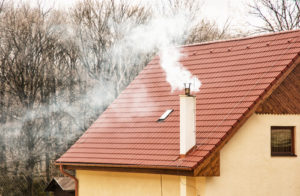The Advantages and Disadvantages of Wood-Burning Appliances
It’s the season of pumpkin-spice-lattes, corn mazes, and steaming cocoa by a crackling fire. Many homeowners use the fireplace as a home decor focal point, a backdrop for family photos and festivities, and supplemental heat. You may not have a fireplace yet and desperately want one. A properly-installed or well-constructed fireplace or fire appliance can bring up the value of your home, help decrease utility bills, and enhance the holiday spirit. The fan favorite is the wood-burning fireplace because of the natural ambiance it creates. Wood produces beautiful flames, crackling and hissing of the wood, and has high heat output. It isn’t all wonderful, however. There are drawbacks to choosing wood, but we can help. 
Benefits of Wood Fires
Accessibility of fuel – When you choose wood-burning appliances, you are able to use wood from your own land or personal supply. You simply have to cut, store, and haul wood yourself. If you don’t have a readily accessible wood supply, you can find a local supplier quite easily. Just make sure your wood is properly-seasoned and that you’re getting what you pay for.
High heat output – When you choose your wood type, you can even control how much heat your fire produces. Today’s wood-burning appliances are equipped with many new technologies that allow better control of temperature as well.
Eco-friendly – Today’s manufacturers have made strides to produce high-efficiency wood-burning appliances. Wood furnaces, stoves, inserts, and fireplaces can be highly-efficient and leave less of a “carbon footprint” than ever before.
Versatile designs and models – The wood-burning appliance used to lend itself to rustic decor only, but no more. Now you can choose a wood-burning appliance that compliments a sleek contemporary look, a traditional rustic one, or any variety in between.
Drawbacks to Burning Wood
Wood fires require more service appointments than gas or pellet appliances. This is not due to the performance of the appliance, but rather the material burned. Gas is the cleanest burning fuel, so it produces no creosote and very little soot. Pellets appliances burn at such high-efficiency that they also produce less waste. However, firewood, even properly-seasoned firewood, will produce soot and creosote no matter how well it burns. It also produces ash which can be a pain to remove and dispose of and the wood chips and dust can make a mess. When you’re burning wood, half the work is in cleaning up the mess. Fortunately, a lot of that work should be done by the professionals.
Chief Chimney Services Wood Appliances
If you have a wood-burning appliance and haven’t had it inspected or cleaned in the last 12 months, now is the time. Keeping the appliance well-maintained through professional services will keep it working safely and properly. Call us at 631-863-2460 and talk with a professional about economical wood-burning appliances today.

